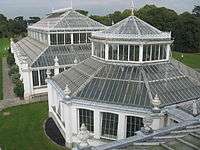Temperate House


The Temperate House, opened in 1862, is a Grade I-listed showhouse for Kew's largest plants. Rectangular, with pitched roofs, its pillars support wrought-iron ribs. Decimus Burton, the designer, gave the House a mix of decorative motifs, finials, pediments, acanthus leaf capitals, Coade stone urns and statues. According to Greg Redwood, Kew's head of glasshouses, "The effect is similar to the contemporary iron pier pavilions of Eugenius Birch."
It was positioned to be the first feature visitors saw as they entered the gates with the anticipated coming of the first railway station at Kew expected to be at the end of the adjacent avenue. However, Kew Gardens station (London), was built 500 yards to the north - leaving the glasshouse "somewhat stranded in the landscape". [1]
In 2011 Kew had to launch a £15m public appeal to address needed repairs to the Temperate House. An early exercise in cast- and wrought-iron and glass construction, the building is structurally sound but the Victorians hid utilitarian features liked drainpipes inside the stone columns. Water round the edge of the building leads to rust on the iron to push against the masonry which is falling away. Decorative features made of wood are rotting. It last underwent a major restoration in the late 1970s.
References
- ↑ The Independent, Jack Watkins A cracking piece of design, 1 September 2011
Coordinates: 51°28′29″N 0°17′44″W / 51.4746°N 0.2955°W